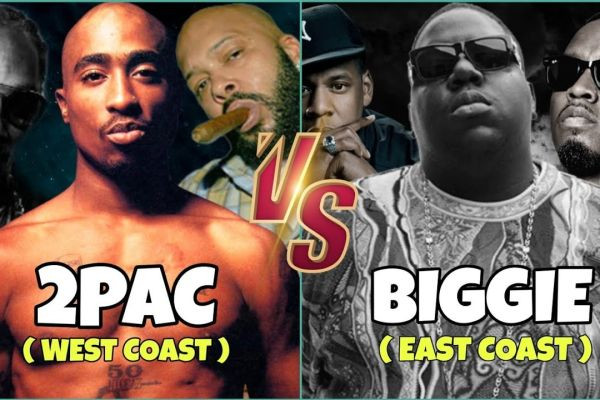Introduction:
Hip-hop, a genre that originated in the streets of New York City in the 1970s, has grown into a global cultural phenomenon. As it expanded across the United States, it gave rise to two distinct epicenters of creativity and influence: the East Coast and the West Coast. Over the years, these two coasts have engaged in a legendary hip-hop rivalry, a clash of styles, personalities, and perspectives that has left an indelible mark on the history of music.
The Birth of the Epic East Coast Hip-Hop:
The East Coast is considered the birthplace of hip-hop, and it set the stage for the genre's initial explosion. Pioneering artists like Grandmaster Flash and the Furious Five, Run-D.M.C., and LL Cool J laid the groundwork for the rap movement. The East Coast was characterized by its intricate lyricism, storytelling, and emphasis on social issues and cultural commentary. With its origins in the Bronx and Harlem, the East Coast quickly became the heartbeat of hip-hop's early years.
The Rise of the West Coast Hip-Hop:
As hip-hop began its westward journey, it found a new home on the streets of Los Angeles and Compton. The West Coast brought its unique flavor to the genre, incorporating a laid-back, funk-infused sound. Artists like N.W.A., Ice-T, and Ice Cube pushed boundaries with their gritty and unapologetic lyrics, often shining a spotlight on the realities of inner-city life and gang culture. The West Coast's emergence marked the birth of gangsta rap, which would become a defining sub-genre within hip-hop.
Hip-Hop Rivalry: The Beef that Shaped an Era:
With the rise of the East and West Coasts as dominant forces in hip-hop, competition naturally ensued. The rivalry between the two coasts intensified during the late 1980s and early 1990s, fueling a series of publicized conflicts and feuds. Perhaps the most infamous feud was the one between East Coast rapper The Notorious B.I.G. and West Coast rapper Tupac Shakur, which ultimately resulted in both artists' tragic deaths.
Style and Substance: Contrasting Philosophies:
The East Coast and West Coast hip-hop scenes diverged in terms of style and substance. While the East Coast focused on intricate wordplay and storytelling, the West Coast placed an emphasis on beats and laid-back flows. The East Coast sought to address social and political issues, often acting as a voice for marginalized communities, while the West Coast presented a raw and unfiltered perspective on urban life. These differences in approach contributed to the ongoing rivalry between the two coasts.
Influence on Pop Culture and Beyond:
The epic East Coast vs. West Coast hip-hop rivalry not only shaped the music industry but also left an enduring impact on popular culture. The media's intense coverage of the feuds and conflicts between artists from both coasts brought hip-hop into the mainstream spotlight. The rivalry also acted as a catalyst for the globalization of hip-hop, propelling the genre to new heights of international popularity.
Peace and Unity: Healing the Rift
As the rivalry escalated, the hip-hop community also recognized the destructive consequences of the conflicts between the East Coast and the West Coast. Many artists and fans sought to promote peace and unity within the genre. In 1996, just months after the tragic deaths of Tupac Shakur and The Notorious B.I.G., the Nation of Islam organized the "Day of Atonement" summit in Harlem, New York. This event brought together prominent figures from both coasts in an attempt to broker peace and put an end to the senseless violence that had plagued the hip-hop world.
Collaborations and Cross-Coast Bonds
Over time, artists from both the East Coast and West Coast started to bridge the gap, realizing the value of collaboration and cultural exchange. Joint projects between artists from different coasts began to emerge, breaking down barriers and fostering a newfound sense of camaraderie. Hip-hop luminaries like Jay-Z and Dr. Dre collaborated on tracks, demonstrating that unity could be achieved, even in the face of past rivalries.
The Evolution of Hip-Hop: Beyond Coasts
As hip-hop continued to evolve, the rivalry between the East Coast and West Coast gradually became less pronounced. New sub-genres and regional styles began to emerge, expanding the genre's diversity and reaching beyond the traditional geographic boundaries. Southern hip-hop, for instance, gained prominence with artists like OutKast, UGK, and Lil Wayne, while Midwest hip-hop with acts like Eminem and Common also garnered significant attention.
Legacy and Inspiration: A Lasting Impact
Despite the rivalry's waning intensity, its legacy endures within hip-hop's collective memory. The events and conflicts from that era have become cautionary tales, reminding the hip-hop community of the importance of unity and understanding. The artists who tragically lost their lives during this period are revered as icons who left behind powerful musical legacies, inspiring generations of aspiring rappers and producers.
Hip-Hop's Global Dominance
The epic East Coast vs. West Coast hip-hop rivalry undoubtedly played a role in hip-hop's journey from a niche subculture to a global phenomenon. Today, hip-hop is one of the most influential and widely consumed genres worldwide, transcending cultural and linguistic boundaries. It has become a unifying force, connecting people from diverse backgrounds, and its impact can be seen in various facets of popular culture, including fashion, language, and even politics.
The Resurgence of East Coast and West Coast Sounds In recent years, there has been a resurgence of the distinctive East Coast and West Coast sounds that defined the rivalry's early years. Artists from both coasts have embraced their regional roots, blending traditional elements with modern influences. The East Coast has seen a resurgence of lyricism and storytelling with artists like Kendrick Lamar, J. Cole, and Joey Bada$$, who carry on the legacy of their predecessors while pushing the boundaries of their craft.
On the other hand, the West Coast has witnessed a revitalization of its classic G-funk and gangsta rap styles with the rise of artists like Kendrick Lamar, Schoolboy Q, and YG. These artists pay homage to their West Coast roots while infusing their music with contemporary sounds and social commentary, keeping the essence of West Coast hip-hop alive.
Legacy of Unity:
Hip-Hop's Collaborative Spirit As hip-hop evolved and matured, the focus on unity and collaboration within the community became stronger. Artists from different coasts regularly collaborate on projects, breaking down the barriers that once separated them. The spirit of camaraderie has given rise to powerful cross-coast collaborations, reminding everyone that hip-hop is a global movement that transcends geographical rivalries.
Influencing Other Genres:
Hip-Hop's Cross-Genre Impact Beyond the realms of hip-hop, the East Coast vs. West Coast rivalry has had a profound impact on other music genres as well. It paved the way for artists to engage in friendly rivalries and healthy competition, which have become prevalent in various music scenes. Elements of hip-hop have also seeped into pop, R&B, and even rock music, enriching these genres with new styles, rhythms, and storytelling techniques.
Social Impact:
Hip-Hop as a Catalyst for Change Throughout its history, hip-hop has served as a powerful platform for social change and activism. The East Coast vs. West Coast rivalry era was no exception, as artists on both coasts addressed critical social issues through their music. Today, hip-hop continues to be a driving force in advocating for social justice, racial equality, and political awareness.
Looking Ahead:
The Future of Hip-Hop As hip-hop moves further into the 21st century, its future remains as bright as ever. The genre continues to evolve, reflecting the changing cultural landscape and the experiences of new generations. While the epic East Coast vs. West Coast rivalry may have defined hip-hop's past, it is the genre's ability to adapt, embrace diversity, and foster unity that will shape its future.
Conclusion:
The epic East Coast vs. West Coast hip-hop rivalry will forever be etched in the annals of music history. What began as a clash of coasts ultimately transformed into a unifying force that bridged gaps and brought people together. Today, hip-hop stands as a testament to the power of artistic expression, influencing generations and transcending borders. As we move into the future, we celebrate hip-hop's journey, remembering its roots while eagerly anticipating the next chapter in its ever-evolving story.
 Bitcoin: $97835.37 0.84%
Bitcoin: $97835.37 0.84%  Ethereum: $3409.87 3.17%
Ethereum: $3409.87 3.17%  Tether: $1.00 0.06%
Tether: $1.00 0.06%  Solana: $256.24 0.46%
Solana: $256.24 0.46%  BNB: $658.73 5.68%
BNB: $658.73 5.68%  XRP: $1.48 0.12%
XRP: $1.48 0.12%  Dogecoin: $0.43 7.76%
Dogecoin: $0.43 7.76%  USDC: $1.00 0.02%
USDC: $1.00 0.02%  Cardano: $1.06 10.63%
Cardano: $1.06 10.63%  Lido Staked ETH: $3389.46 3.14%
Lido Staked ETH: $3389.46 3.14%  TRON: $0.21 7.13%
TRON: $0.21 7.13%  Avalanche: $41.93 6.39%
Avalanche: $41.93 6.39%  Shiba Inu: $0.00 4.99%
Shiba Inu: $0.00 4.99%  Stellar: $0.49 61.38%
Stellar: $0.49 61.38%  Wrapped Bitcoin: $97438.86 0.99%
Wrapped Bitcoin: $97438.86 0.99%  Polkadot: $8.54 35.44%
Polkadot: $8.54 35.44%  Chainlink: $17.38 11.97%
Chainlink: $17.38 11.97%  Bitcoin Cash: $509.03 4.83%
Bitcoin Cash: $509.03 4.83%  UNUS SED LEO: $8.61 1.31%
UNUS SED LEO: $8.61 1.31%  NEAR Protocol: $6.26 11.33%
NEAR Protocol: $6.26 11.33%  Litecoin: $99.23 10.42%
Litecoin: $99.23 10.42%  Uniswap: $10.82 14.58%
Uniswap: $10.82 14.58%  Internet Computer: $11.56 14.54%
Internet Computer: $11.56 14.54%  Multi Collateral DAI: $1.00 0%
Multi Collateral DAI: $1.00 0%  Crypto.com Coin: $0.19 2.91%
Crypto.com Coin: $0.19 2.91%  Sp8de: $0.59 13.07%
Sp8de: $0.59 13.07%  Ethereum Classic: $29.78 6.13%
Ethereum Classic: $29.78 6.13%  VeChain: $0.04 31.17%
VeChain: $0.04 31.17%  Artificial Superintelligence Alliance: $1.39 12.24%
Artificial Superintelligence Alliance: $1.39 12.24%  Filecoin: $5.32 12.4%
Filecoin: $5.32 12.4%  Stacks: $2.09 7.07%
Stacks: $2.09 7.07%  OKB: $50.49 11.28%
OKB: $50.49 11.28%  Monero: $160.35 0.94%
Monero: $160.35 0.94%  Aave: $176.82 7.24%
Aave: $176.82 7.24%  Fantom: $0.88 23.91%
Fantom: $0.88 23.91%  Algorand: $0.30 22.2%
Algorand: $0.30 22.2%  The Graph: $0.24 13.68%
The Graph: $0.24 13.68%  Hedera Hashgraph: $0.15 10.79%
Hedera Hashgraph: $0.15 10.79%  Injective: $28.34 15.65%
Injective: $28.34 15.65%  Cosmos: $8.30 13.33%
Cosmos: $8.30 13.33%  THORChain: $5.68 7.65%
THORChain: $5.68 7.65%  THETA: $1.92 13.75%
THETA: $1.92 13.75%  MANTRA DAO: $3.69 0.64%
MANTRA DAO: $3.69 0.64%  Raydium: $5.94 2%
Raydium: $5.94 2%  Arweave: $22.30 26.4%
Arweave: $22.30 26.4%  Maker: $1651.75 0.62%
Maker: $1651.75 0.62%  Bitcoin SV: $70.83 5.62%
Bitcoin SV: $70.83 5.62%  KuCoin Token: $11.40 2.97%
KuCoin Token: $11.40 2.97%  Polygon: $0.57 22.24%
Polygon: $0.57 22.24%  Flow: $0.84 16.3%
Flow: $0.84 16.3%  Quant: $101.50 18.43%
Quant: $101.50 18.43%  Gala: $0.03 16.15%
Gala: $0.03 16.15%  Lido DAO: $1.34 9.29%
Lido DAO: $1.34 9.29%  EOS: $0.77 8.55%
EOS: $0.77 8.55%  Tezos: $1.14 2.78%
Tezos: $1.14 2.78%  Neo: $14.66 10.2%
Neo: $14.66 10.2%  Axie Infinity: $6.71 13.74%
Axie Infinity: $6.71 13.74%  Decentraland: $0.51 19.82%
Decentraland: $0.51 19.82%  The Sandbox: $0.42 16.15%
The Sandbox: $0.42 16.15%  Helium: $5.82 6.75%
Helium: $5.82 6.75%  Akash Network: $3.95 6.4%
Akash Network: $3.95 6.4%  GateToken: $10.97 8.35%
GateToken: $10.97 8.35%  AIOZ Network: $0.82 12.48%
AIOZ Network: $0.82 12.48%  eCash: $0.00 3.81%
eCash: $0.00 3.81%  Pendle: $5.33 7.16%
Pendle: $5.33 7.16%  Nexo: $1.35 3.12%
Nexo: $1.35 3.12%  MultiversX: $36.08 18.98%
MultiversX: $36.08 18.98%  Mina: $0.72 7.79%
Mina: $0.72 7.79%  FTX Token: $2.49 0.81%
FTX Token: $2.49 0.81%  Conflux: $0.17 11.46%
Conflux: $0.17 11.46%  Zcash: $48.03 6.22%
Zcash: $48.03 6.22%  Chiliz: $0.09 11.8%
Chiliz: $0.09 11.8%  IOTA: $0.22 20.5%
IOTA: $0.22 20.5%  Gnosis: $271.56 4.35%
Gnosis: $271.56 4.35%  Oasis: $0.10 17.07%
Oasis: $0.10 17.07%  XinFin Network: $0.05 18.63%
XinFin Network: $0.05 18.63%  SuperVerse: $1.34 9.42%
SuperVerse: $1.34 9.42%  PancakeSwap: $2.18 12.1%
PancakeSwap: $2.18 12.1%  Nervos Network: $0.01 7.98%
Nervos Network: $0.01 7.98%  Curve DAO Token: $0.50 13.75%
Curve DAO Token: $0.50 13.75%  Kusama: $36.97 71.72%
Kusama: $36.97 71.72%  Compound: $64.63 19.73%
Compound: $64.63 19.73%  Kava: $0.49 8.06%
Kava: $0.49 8.06%  TrueUSD: $1.00 0.07%
TrueUSD: $1.00 0.07%  DeXe: $8.50 2.2%
DeXe: $8.50 2.2%  NXM: $73.31 5.14%
NXM: $73.31 5.14%  Theta Fuel: $0.07 6.79%
Theta Fuel: $0.07 6.79%  1inch Network: $0.37 8.11%
1inch Network: $0.37 8.11%  Zilliqa: $0.02 15.19%
Zilliqa: $0.02 15.19%  Synthetix: $1.99 10.88%
Synthetix: $1.99 10.88%  WOO: $0.24 12.63%
WOO: $0.24 12.63%  Celo: $0.80 12.12%
Celo: $0.80 12.12%  Reserve Rights: $0.01 10.42%
Reserve Rights: $0.01 10.42%  Trust Wallet Token: $1.01 5.37%
Trust Wallet Token: $1.01 5.37%  Livepeer: $11.71 11.49%
Livepeer: $11.71 11.49%  IoTeX: $0.04 5.69%
IoTeX: $0.04 5.69%  Enjin Coin: $0.23 15.44%
Enjin Coin: $0.23 15.44%  Holo: $0.00 10.63%
Holo: $0.00 10.63%  Amp: $0.01 8.19%
Amp: $0.01 8.19%  Dash: $33.09 13.28%
Dash: $33.09 13.28% 








